This story is a continuation of Bootcamp. You don't need to read the first one in order to understand the sequel (just like J.K. Rowling said about the Harry Potter series), but it might help.
After three years of rigorous, structured tasks in the army where I completed my military duty to my country, I finally came back home, back to the farmer's slow-paced no-hurry routine I had been used to before I left my family. It felt good to be able to wake up any time I liked, help out my parents and brother on the farm, wash in a clean bathroom without the wimpy city boys' clothes lying around the shower box (as if they expected a maid to come and pick up after them), eat my mother's home cooked meals meals and sleep in my own warm bed with clean white sheets, my days of smelly grey bedspreads being well and truly over. It felt good, all right, but it did not pay. After spending three years becoming an andra, I had also lost three years of my working life. As a high school graduate with no specific skills, I was unemployed and unemployable. A year after returning home, I decided to further my knowledge by studying tourism management - in London.
In the last week before I left the village, all my aunts, uncles and cousins invited me to their house for lunch or dinner. Every single day, I ate two feasts, one at midday and one in the evening, and no dish resembled any other that I had eaten on another day. Everyone cooked with my tastes in mind, and all my relatives conjured up sumptuous meals, often killing one of their animals especially for the occasion.
"You've seen them when they come here, Nikita," my Aunt Marika said to me, "all skin and bone, but no meat. Make sure you eat well before you leave the village, they might not have any food in Agglia," she joked.
"They probably cook a lot of lahanorizo," my brother replied, and we both burst out laughing at our private joke.
"Lahanorizo? Who cooks that these days?" she asked. Aunt Marika had no idea what it meant to be force-fed lahanorizo twice a day twice a week.
On Monday, I had avgolemono stew for lunch at her house, and stifado for dinner at her son's house, my cousin and best friend, if you can call your cousin your best friend. Upon finishing junior high school, Manolis had stayed with his parents helping them out on the farm and the olive trees. When he turned eighteen, he began his military duty in the navy. He preferred his own island to his base at Poros, he hated the petroleum-smelling cabins that the cadets slept in, he hated everything about his time there. When he finally came back to the village, he vowed never to leave the place, marrying a girl from a neighbouring village and setting up home here for good. He lived in a house which he had built himself, room by room, over his parents' stone-built rustic dwelling. He was only thirty years old, and had three children under five; his wife was expecting again.
"The hardest work is over," he said to me over dinner. "We might as well go for the jackpot and become politekni."
"But what if they're twins, Manolis?"
"They are," he replied. "What's the problem? I've got 200 stremmata - there's plenty there for all of them."
The menu for the rest of the week continued pretty much on the same meaty basis that it had started. I had never eaten so much meat before in that week alone, not to mention my mother's traditional Sunday roast prior to that. And no one dared to bring out a plate of horta or olives to the table. They were reserved for 'poorer', more 'sombre' days, while I had become an overnight cause celebre. What I particularly craved was a simple plate of stamnagathi, but when I asked my hosts once if they had any left over from one of their own meals, they looked at me as if I had no sense of taste.
"Horta? Mipos nisteveis? It's not the time to be fasting, Nikita," my Aunt Kriti scolded me. Her godfather had been a Venizelos supporter, who believed in the dream of a free independent Cretan republic. Custom dictated that the godparent choose the name of the child, and not the parents. No one could override the choice of name when the godparent chose it. He could choose it right at the last moment, before the child was being dipped into the baptismal font. And when the priest said:
everyone waited expectantly to hear what name my aunt's godfather had chosen.
"Κρήτη!" cried the godfather triumphantly.
"Κρήτη," repeated the priest, "εις το όνομα του Πατρός και του Υιού και του Αγίου Πνεύματος, Αμήν."
And Kriti she was, taking the name of the island where she would live her whole life. Her sister completed the picture when her godfather named her Laokratia.
*** *** ***
The Saturday before my departure was to be a special one. It would be spent at home in the company of my closest relatives. My father was going to kill a lamb and my mother would make one of my favorite meals, usually reserved for Easter. It was still warm in the middle of September, warm enough to sit outdoors under a verandah to keep away the chill of the evening as autumn approached the Mediterranean. Christmas was only a few months away, but the distance between London and Crete made it feel longer. Since I was embarking on a strange journey into unknown territory, Easter would have to come twice this year.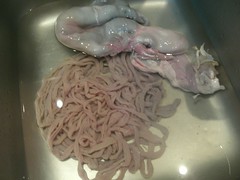
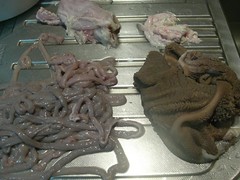
This is the second time in my life that I have made these on my own; I used the cleaning method my own mother used (having committed it to memory) when she made the same food in New Zealand, except that the size of each part of the animal there was twice the size of the spring goat I was using.
Just after the lamb was killed, my father brought a foul-smelling bucket into the kitchen and my mother set to work on it. Gardoumia could only be made freshly. She began to meticulously clean every item in the bucket: the stomach, the spleen, the intestines and the fat, taking care not to break them up too much. She let a running tap of water flow through the guts, which swelled up like a sausage balloon, the kind gypsies sell in the shape of a dog.
She then went out into the garden and brought back a thin twig from an olive tree. This was the tool she used to turn the intestines inside out to clean them thoroughly, so that all traces of scum had been cleared. As she cleaned all the inner parts of the animal, she washed her hands with plain water, so as not to taint the meat with the smell of soap. Then she smelled her hands; when she was satisfied that she couldn't smell dung, she knew that the guts were clean.
She then went out into the garden and brought back a thin twig from an olive tree. This was the tool she used to turn the intestines inside out to clean them thoroughly, so that all traces of scum had been cleared. As she cleaned all the inner parts of the animal, she washed her hands with plain water, so as not to taint the meat with the smell of soap. Then she smelled her hands; when she was satisfied that she couldn't smell dung, she knew that the guts were clean.
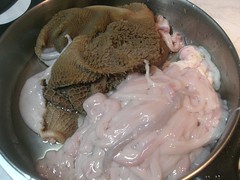
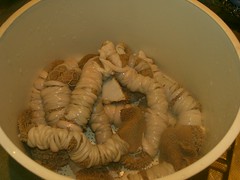
Cleaning the intestines is of utmost importance before they are wound round the animal's stomach to make gardoumia (also called 'kilidakia'). Compare the colour of the intestines in the left hand photo with those in the previous photos.
Then she called me over to help her cut the round spleen into one long thin strip of blood red meat. This she used to stuff the large intestine, so that it looked like a thin warped stiff sausage. She cut off uniform sizes of the tripe and fat. Tucking a little bit of fat into the tripe, she carefully rolled the intestines very tightly round it, fastening them off with a knot at the end, and snipping them off to repeat the process for the next gardoumi. When she had finished making them, she gave everything one last wash and placed them on a clean plate in the fridge.
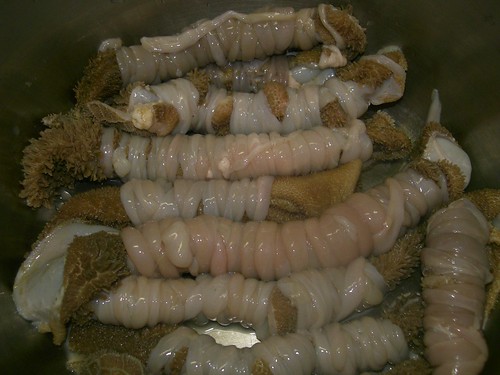
The large intestine which holds the spleen is called the 'splinogardoumo'; unfortunately, it was either destroyed or not passed on to us when we ordered the kid at Easter, possibly due to EC regulations which demand that it be disposed of hygienically and not eaten to avoid the risk of transmissible spongiform encephalopathies (TSE), despite the fact that Greeks have been using these parts of the animal as human food since ancient times.
As it was the tail-end of summer, she picked the last zucchini crop from the garden and chopped them lengthwise into thick rods. These were fried in olive oil, strained on absorbent paper and set aside. Then she got the potatoes ready, chopping them in a similar way without cooking them. Tomatoes are still in plentiful supply at the beginning of autumn; she grated the reddest softest fruit into a bowl. Everything was ready for the gardoumia, which she knew I preferred to eat in a red sauce rather than the traditional way we ate them at Easter, in avgolemono sauce.
I had prepared the koilidakia just before Easter, but didn't want to cook them at that time, so I plunged them in boiling water for five minutes to kill off any contaminants. After letting them drain well, I froze them and cooked them in the summer with the new zucchini crop.
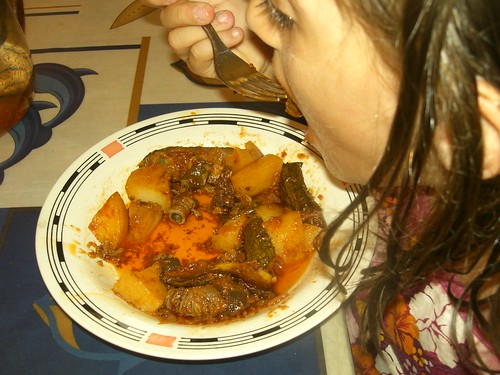
"Mmm, tastes rather like snails, doesn't it, Mum," exclaimed my 'good' eater, who has developed a refined sense of taste, recognising the same ingredients used in my summer snails recipe. My son turned down his portion. I know I'm spoiling them - how will they survive when they leave the family nest?
And that meal constituted the last one I was to eat in Crete for a long time. It was one of the biggest family celebrations I had ever been a part of in my life. I was the first person in my family to go to university, and to set foot in a foreign land. No one, not even myself, knew what to expect in the place I was setting out for...
Let's hope it won't be like what happened to that poor chap in North London...
*** *** ***
Although it's highly unlikely that you will make gardoumia yourself, here's the recipe for it.
You need:
the intestines of a lamb or goat, along with the animal's stomach and some fat lining the stomach, cleaned meticulously and prepared in the manner described in the story (these sausage-like rolls are called gardoumia)
1/2 cup to 1 cup of olive oil (this depends on how oily you like your food; this kind of meal tastes better in a lot of olive oil)
1-2 large onions chopped roughly
2 cloves of garlic minced finely
a cup of water
half a wineglass of red wine
4 zucchini cut into thick slices lengthwise, fried till golden, and drained on absorbent paper
3-4 potatoes cut into thick slices lengthwise
4 ripened tomatoes, pureed
1 tablespoon of tomato paste
salt and pepper
Heat the oil and saute the onion and garlic in it till translucent (do not let it burn). Add the gardoumia and coat them well in the oil. Add the tomato puree and tomato paste, along with the water, and mix well. Cover the pot with a lid and let the gardoumia cook for an hour. Then add the wine and cover the pot again, cooking for another 30 minutes. Add the potatoes and seasonings, cover the pot again and let the potatoes cook till nearly soft. Add more water if necessary (eg if you think there is not enough liquid in the pot and the food looks as though it is about to stick to the pan). Add the fried courgettes and let everything cook together for the last 15-20 minutes for the flavours to blend.
The gardoumia can be made with an avgolemono sauce instead of a red sauce. This dish is also cooked with lamb's legs - the intestines are wound round them instead of the tripe. Although it's made all over the country with regional differences, gardoumia is especially associated with Crete and island cultures. It is one of the culinary customs that Ibrahim's grandparents took with them when they left Crete in the 1920s and settled in Turkey, and taught their children (you can see Ibrahim's mother in Constantinople making them with trotters in the photo) to make them too, so that their grandchildren (like Ibrahim) could enjoy them nearly a century later.
You need:
the intestines of a lamb or goat, along with the animal's stomach and some fat lining the stomach, cleaned meticulously and prepared in the manner described in the story (these sausage-like rolls are called gardoumia)
1/2 cup to 1 cup of olive oil (this depends on how oily you like your food; this kind of meal tastes better in a lot of olive oil)
1-2 large onions chopped roughly
2 cloves of garlic minced finely
a cup of water
half a wineglass of red wine
4 zucchini cut into thick slices lengthwise, fried till golden, and drained on absorbent paper
3-4 potatoes cut into thick slices lengthwise
4 ripened tomatoes, pureed
1 tablespoon of tomato paste
salt and pepper
Heat the oil and saute the onion and garlic in it till translucent (do not let it burn). Add the gardoumia and coat them well in the oil. Add the tomato puree and tomato paste, along with the water, and mix well. Cover the pot with a lid and let the gardoumia cook for an hour. Then add the wine and cover the pot again, cooking for another 30 minutes. Add the potatoes and seasonings, cover the pot again and let the potatoes cook till nearly soft. Add more water if necessary (eg if you think there is not enough liquid in the pot and the food looks as though it is about to stick to the pan). Add the fried courgettes and let everything cook together for the last 15-20 minutes for the flavours to blend.
The gardoumia can be made with an avgolemono sauce instead of a red sauce. This dish is also cooked with lamb's legs - the intestines are wound round them instead of the tripe. Although it's made all over the country with regional differences, gardoumia is especially associated with Crete and island cultures. It is one of the culinary customs that Ibrahim's grandparents took with them when they left Crete in the 1920s and settled in Turkey, and taught their children (you can see Ibrahim's mother in Constantinople making them with trotters in the photo) to make them too, so that their grandchildren (like Ibrahim) could enjoy them nearly a century later.
©All Rights Reserved/Organically cooked. No part of this blog may be reproduced and/or copied by any means without prior consent from Maria Verivaki.
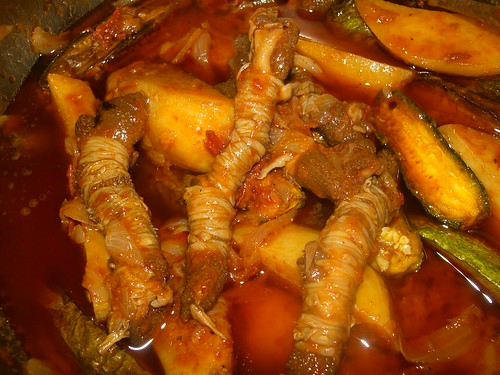

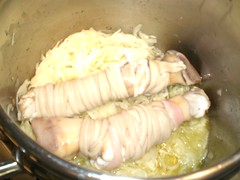
Now this is good eats! I've only eaten the prepared for me. I want to make them but besides Easter, the ingredients can be difficult to find here.
ReplyDeleteI will remedy this next year.
PS...you're fortunate to have kids with such liberal eating habits.
Ohhh! Gardoumbes! Believe it or not its one of my favorite dishes by far!!! Its a shame I can not find the ingredients very often...
ReplyDeleteI haven't enjoyed this dish yet. I've only enjoyed tripe in patsa. It looks like a flavorful way to prepare all these ingredients. And it's so great that your daughter enjoys these dishes.
ReplyDeleteI know some people absolutely love this food but I am afraid I can barely look at it!
ReplyDeleteHurray for new food tryers.
ReplyDeleteEven though this dish may appear a little dicey to the faint of heart (myself included, I'll admit), I have to say that was also my reaction the first time I ever ate the Mexican soup, menudo. Now I can't get enough of it. So, as my father always cautioned me, try something before you turn your nose up at it. You just might find yourself craving it later!
ReplyDeleteThere is absolutely nothing that puts me off this dish! I would love to try it but seriously doubt I can find any place that serves it (except, perhaps, in a much larger city than Minneapolis). And you're right: it's certain that I would not make it myself, if only because of the tremendous amount of time and energy it takes! But I will happily eat it . . . !
ReplyDeleteThat looks like a lot of hard work, but it would be very satisfying to see every bit of the animal used. Your daughter is very adventurous - you should be proud!
ReplyDeleteMaria, I am very impressed with you making this all by yourself! My mother and her neighbors used to make this maybe once or twice a year. I used to hate it when I was a kid, however now I actually would like to eat some. I do remember the cleaning process. It was very labor intensive, however every single intestine and stomach lining that was brownish turned snow white. They also boil them so that the rubbery texture is removed from the stomach lining. I liked them grilled after being boiled. I think your recipe is very interesting and sounds tasty. I've never seen it cooked this way. I wish I could try it!
ReplyDelete